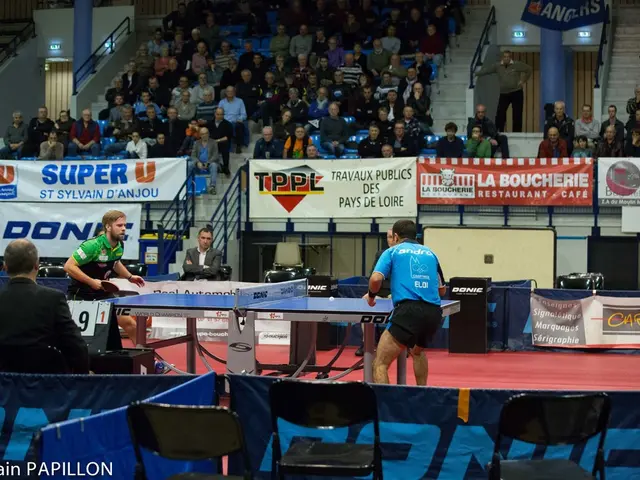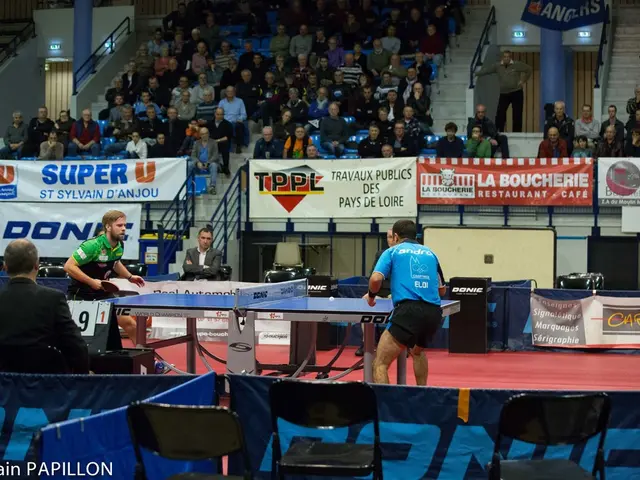Wagers categorized as over/under bets explained
There's a whole wicked world of bets out there, but some don't pack the same punch as Over/Under bets. Unlike most other bets that focus on the winner, these bad boys are all about whether more or fewer events will happen than the bookie thinks. We're talkin' points, goals, games—you name it.
Let's say you're watchin' a soccer match between Team A and Team B, and the bookie's set the line at 2.5 goals. Suppose you think there'll be at least three goals scored, you can take an Over bet ("Over 2.5"). If three or more goals are scored, you win. If two or fewer goals are scored, it's all about that sweet bookie's money again. But hell, if you're thinkin' it'll be a low-scoring game, you can knock back an Under bet ("Under 2.5"). You're hopin' for a butt-kickin' defense and fewer goals scored.
Now, here's the kicker. This bet type covers a wide range of scenarios, so you can still take home the win even if that underdog with the wobbly knees pulls it off—as long as you nailed the total points or goals, baby. Plus, you don't have to do the time-consuming grunt work of splitin' hairs over roster comparisons or individual player performances. There's more, though. Over/Under bets have some sneaky little secrets up their sleeves.
See, bookies can set the limit at whole or half values, like 2.5 goals. With a half value, the pinch hitter ain't the draw—you either Over or Under. But with a whole value like 2 or 3, your bet could end in a "Push" if exactly that number of goals are scored.
Now that we've got ya beggin' for more, let's dive a little deeper into this saucy bet type.
Breakin' 'Em Down: The Fine Print on Over/Under Bets
These bets aren't solely about guessin' whether a certain team's gonna win or not. They're all about guessin' whether a certain number of events will happen or not, like goals, points, runs, games, or sets. Depends on the sport. The betting provider sets a line, like 2.5 goals in soccer or 220.5 points in basketball. Your task is as simple as honky-tonk: decide whether this number will be exceeded or not.
This bet type's popularity comes from the fact that it covers a whole spectrum of different scenarios. You can win even if the underdog takes the fight—just as long as your guess about the total points or goals is on the money. And here's the beauty: you don't have to back any ol' team or player. Unlike many other bet types, yer not expected to do deep-dive analyses on roster comparisons or individual player performances. While those can help, yer not bound by 'em.
But hey, this ain't a walk in the park. There's a clever game goin' on behind the scenes. Subtleties within Over/Under bets mean the bookies have got a few tricks up their sleeves. For example, they can set the limit at half values or whole values. A half value, like 2.5 goals, only gives you two options: Over or Under—no draws here, buddy. But a whole value like 2 or 3 can potentially lead to a "Push" if exactly that number of goals is scored.
Are you ready to click your heels together and wanna learn more? We got ya.
How Do They Work? Breakin' Down Over/Under Bet Examples
Wanna know how this nitty-gritty stuff works in the real world? Here are a few examples to get ya started.
Imagine Team A is playin' Team B in a soccer match. The bookie's set the value at 2.5 goals. If you think at least three goals are gonna be scored, you place an Over bet ("Over 2.5"). If three or more goals are scored, you win. If two or fewer goals are scored, you take the L. Ain't rocket science, is it? But how about an Under bet? Here, you're crossin' your fingers and hopin' for a low-scoring game. And the wins get juicier as you push your bet further away from the assumptions. Suppose the line's 2.5, but you bet on more than 4.5 goals. That's the kind of gamble that can get you some serious dough.
The Lowdown on Over/Under Bets Across Different Sports
Over/Under bets are versatile as hell and can be adapted to almost any team sport and numerous individual sports. But it's worth keepin' in mind that the markets differ greatly depending on how points or goals are scored in the respective discipline.
Football
Far and away, Over/Under bets are most popular in football. Classic limit lines are set at 2.5 or 3.5 goals. Since the average football game ain't exactly brimmin' with goals, this creates a super fun atmosphere where every score could potentially make or break yer bet. And remember, offensive and defensive tactics play a crucial role in the number of goals scored. For example, a team with a strong defense might make an Under bet appealing, while a team with a powerful attack might suggest an Over bet.
Especially in derby matches or cup games, when emotions are runnin' high, there's a greater chance of an offensive explosion—makin' an Over/Under bet a thrill-seeker's wet dream. But don't just bet on the team SPITTIN' FIRE—take a look at yer stats, including shooting frequency, xG (Expected Goals), and defensive strength, to make more informed bets.
Basketball
Over/Under bets can be particularly lucrative in basketball, where many more points are scored than in football. The lines are usually set above 200 points. The differences between Over and Under bets can be more pronounced here. A key focus is on the pace of play. Teams that like a fast-paced style score more points, while teams that slow things down score fewer.
Individual player skills play a big role—especially superstars. If a player like Stephen Curry's been on fire, knockin' down three-pointers with ease, it can boost a team's point average and make an Over bet more temptin'. But hey, don't just focus on the one dynamo player—the overall team performance is what really matters. An injury to key players or a strong defensive performance can quickly reduce their usual point output. So, it's essential to keep an eye on the entire team.
Tennis
In tennis, Over/Under bets adapt to the peculiarities of individual sports. Lines may refer to the number of games or sets played. Depending on the tournament type, the limit could alter based on the number of winning sets or games.
To assess whether many or few games or sets will be played, it's worth lookin' at the playin' styles of the opponents. For example, an ace-serve specialist tends to have longer sets due to fewer break opportunities. So, an Over bet on games might be more appealing for ya. But a match between two strong returners could be decided quickly—makin' an Under bet on games a profitable choice.
Up next, let's talk about livin' on the edge—livin' bettin' in real time during a game. This shizz is called live Over/Under bettin', and it's all about staying on your toes.
Live Over/Under Betting: The Excitement of Real-Time Dynamics
Live Over/Under bets allow you to react to events as they unfold, which can be particularly lucrative if you quick catch a change in the game's direction. For example, if an underdog takes an early lead, the favored team may be forced to take more risks, openin' up more scoring chances. In that scenario, an Over bet on points might be more appealing to you—'cause you can live-assess the reactive tactical adjustments yer bettin' on. But remember, livin' bettin' ain't for the faint of heart. You've gotta analyze and decide quickly before the odds change again. And steer clear of emotion-driven decision-makin'. That'll only get ya into trouble.
Combination Bets: Over/Under and More
Some folks try to incorporate Over/Under tips into combination bets. Combincatin' multiple bets on a single bet slip can increase your chance of overall winnings with a small stake. The advantage lies in bigger winnings with a smaller stake. But be cautious: every single bet must be correct for the combination bet to win. The risk of a wrong prediction increases with the number of tips yer addin'. If you want to integrate Over/Under bets into combination bets, make sure yer confident in yer bets. Stick to a specific sport, if not a league, where you've got more knowledge about the teams and their playin' styles.
Strategies for Successful Over/Under Betting
Simply followin' your gut feelin' won't get ya far. To bread winning over the long haul, you can't avoid an intelligent approach. Here are strategies to help boost yer hit rate:
Use Comprehensive Statistics
Stats are the backbone of any serious bettin' strategy. Brush up on yer knowledge about teams, players, and overall performance regarding goals or points scored. A common useful tool is the average number of goals or points scored and conceded per team. In football, you can also bet on Expected Goals (xG) to refine yer predictions. In basketball, analyzin' pace and offensive and defensive ratings can help.
Form curves are crucial. If a team's been in a slump for several games, scoring a bunch of goals, it could indicate that an Over is more likel. Conversely, a team that's been defendin' its net like a champ for several games might make an Under more appealing. Analyz’ the history of direct confrontations between the two teams, lookin' for recurring patterns that can help ya get a feel for Over/Under bets.
Common Mistakes and How to Avoid 'Em
Even though Over/Under bets might seem straightforward, there are pitfalls that can hinder ya success. Watch out for these common mistakes:
- Relyin' on gut feelin' instead of analysis: A common mistake is to bet solely based on gut feelin'. Sure, an intuitive decision can sometimes get ya the right numbers, but without systematic considerations, it's hard to stay consistently profitable. Use numbers, stats, and expert opinions to support yer bettin' ideas.
- Too high risk tolerance: Despite an Over bet on many goals soundin' particularly temptin', don't bet recklessly. The risk of guessin' the game outcome wrong can be high.
- Ignorin' external factors: Weather conditions in football, player performance in basketball, court surface in tennis—there are numerous external influences that can significantly impact the flow of points or goals. Ignorin' these factors can lead t'inaccurate predictions.
- Not comparin' bookmakers: Quotas vary greatly between different sports bettin' providers. Comparin' across platforms can help you find better deals for yer Over/Under bet, especially if you're interested in value bettin'.
Over/Under Bets as Part of a Broader Bettin' Strategy
Don't consider Over/Under bettin' in isolation. Integrate 'em into a broader concept. Switchin' things up and mixin' different bet types can help ya better stabilize potential losses. For example, you could place some football bets according to the classic 1X2 principle, sprinklin' in a few Over/Under tips. That way, if one team unexpectedly loses, your Over/Under bet on another game could still win ya somethin'. But remember, a comprehensive strategy is only successful if ya consistently follow it and don''t constantly change it whenever something goes wrong.
- In the realm of handball, Over/Under bets often come particularly useful due to their ability to cover a wide range of scenarios, giving punters a chance to win even if the underdog performs exceptionally well, as long as the total points or goals are correctly predicted.
- In the context of betting, especially with Over/Under bets, you must be aware that bookies have strategies of their own. For instance, they can set the limit at whole or half values, which could result in a "Push" if exactly that number of events occurs, such as goals in a handball match.
- When considering different sports and their suitability for Over/Under bets, handball is no exception. The basic concept remains the same—predict whether the total points or goals will go over or under a specified line. Analyzing individual player performances and team statistics is still crucial for bettors making informed decisions in handball.








